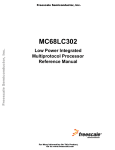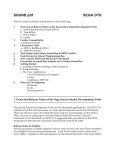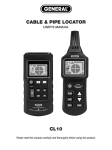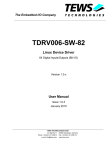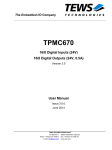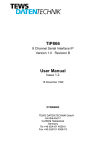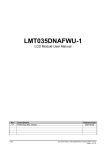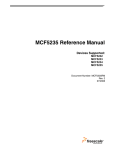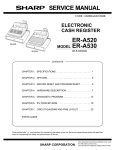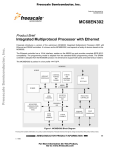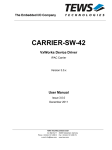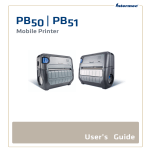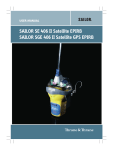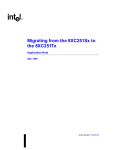Download TIP302 - systerra computer GmbH
Transcript
The Embedded I/O Company TIP302 Multiprotocol Communication IP (based on MC68302) Version 1.0 User Manual Issue 1.5 October 2008 TEWS TECHNOLOGIES GmbH Am Bahnhof 7 Phone: +49-(0)4101-4058-0 25469 Halstenbek, Germany Fax: +49-(0)4101-4058-19 www.tews.com e-mail: [email protected] TEWS TECHNOLOGIES LLC 9190 Double Diamond Parkway, Suite 127, Reno, NV 89521, USA www.tews.com Phone: +1 (775) 850 5830 Fax: +1 (775) 201 0347 e-mail: [email protected] TIP302-12 Multiprotocol Communication IP (based on MC68302) This document contains information, which is proprietary to TEWS TECHNOLOGIES GmbH. Any reproduction without written permission is forbidden. TEWS TECHNOLOGIES GmbH has made any effort to ensure that this manual is accurate and complete. However TEWS TECHNOLOGIES GmbH reserves the right to change the product described in this document at any time without notice. TEWS TECHNOLOGIES GmbH is not liable for any damage arising out of the application or use of the device described herein. © 2002-2008 by TEWS TECHNOLOGIES GmbH All trademarks mentioned are property of their respective owners. TIP302 User Manual Issue 1.5 Page 2 of 21 Issue Description Date 1.0 Initial Issue January 2002 1.1 General Revision February 2002 1.2 Correction of Base Value in Basic Code Example March 2002 1.3 New address TEWS LLC September 2006 1.4 Supplement to Technical Specification September 2007 1.5 Added weight to Technical Specification table October 2008 TIP302 User Manual Issue 1.5 Page 3 of 21 Table of Contents 1 2 3 4 PRODUCT DESCRIPTION ......................................................................................... 6 TECHNICAL SPECIFICATION................................................................................... 7 ID PROM CONTENT .................................................................................................. 8 ADDRESS MAPS ....................................................................................................... 9 4.1 IP Bus Address Map .......................................................................................................................9 4.1.1 I/O Space Addressing ..........................................................................................................9 4.1.1.1 Reset Register............................................................................................................10 4.1.1.2 Interrupt Request Register .........................................................................................11 4.1.1.3 Interrupt Vector Register ............................................................................................12 4.1.1.4 Memory Enable Register ............................................................................................13 4.1.2 Memory Space Addressing ................................................................................................13 4.2 Local Bus Address Map ...............................................................................................................14 4.2.1 On board SRAM.................................................................................................................14 4.2.2 MC68302 System Block.....................................................................................................14 4.2.3 Interrupt Register ...............................................................................................................15 4.2.3.1 Interrupt Vector Register ............................................................................................15 4.2.3.2 Interrupt Request Register .........................................................................................15 4.2.4 Local Bus Address Map Example ......................................................................................16 5 PROGRAMMING ...................................................................................................... 17 5.1 IP Host CPU ...................................................................................................................................17 5.2 MC68302 Program Code...............................................................................................................17 5.2.1 Basic Code Example..........................................................................................................18 5.3 Getting Started ..............................................................................................................................19 6 I/O PIN ASSIGNMENT ............................................................................................. 20 TIP302 User Manual Issue 1.5 Page 4 of 21 Table of Figures FIGURE 1-1: BLOCK DIAGRAM......................................................................................................................... 6 FIGURE 2-1: TECHNICAL SPECIFICATION...................................................................................................... 7 FIGURE 3-1: TIP302-12 V1.0 ID PROM CONTENTS ........................................................................................ 8 FIGURE 4-1: I/O SPACE REGISTERS............................................................................................................... 9 FIGURE 4-2: RESET REGISTER ..................................................................................................................... 10 FIGURE 4-3: INTERRUPT REQUEST REGISTER .......................................................................................... 11 FIGURE 4-4: INTERRUPT VECTOR REGISTER............................................................................................. 12 FIGURE 4-5: MEMORY ENABLE REGISTER.................................................................................................. 13 FIGURE 4-6 : LOCAL BUS ADDRESS MAP EXAMPLE .................................................................................. 16 FIGURE 6-1: I/O PIN ASSIGNMENT ................................................................................................................ 21 TIP302 User Manual Issue 1.5 Page 5 of 21 1 Product Description The TIP302 is an IndustryPack® compatible module with a serial communication I/O interface using the Motorola MC68302 Multiprotocol Communication Processor running at 25 MHz. The MC68302 contains a 68K core processor, a micro-coded RISC communication processor, 6 serial DMA channels, 3 timers, an interrupt controller, 3 independent full-duplex serial communication controllers (SCCs) and 1152 bytes of on-chip RAM. The TIP302 provides TTL level interface for all 3 SCC’s of the MC68302 at the IP I/O connector. A variety of physical layer standards, such as RS232, RS422, RS485 or ISDN are supported by the use of custom transition modules. Internal microcode in the 68302 supports a variety of protocols, such as BISYNC, HDLC, SDLC, UART, DDCMP, V.110, ISDN (2B+D) and transparent modes. The TIP302 provides 1 Mbyte (512 Kbit x 16) of static RAM (SRAM) as dual-port memory for both, MC68302 code and user data. The code is downloaded to the SRAM by the IP host CPU prior to removing the MC68302 reset signal by writing to a control register. Once the MC68302 reset signal is removed, the MC68302 starts fetching code from the SRAM. The SRAM, the MC68302 registers and the MC68302 on-chip RAM are accessible by the MC68302 and by the IP host CPU through arbitration. The local bus arbitration is transparent to the IP host CPU. Both the IP host CPU and the MC68302 are capable of generating interrupts to each other. MC68302 FPGA IP-Local Interface Register ID-PROM Multiprotocol Communication Processor (25MHz) SRAM 512Kbit x 16 Ch2 Ch3 GPIO IndustryPack I/O Interface IndustryPack logic Interface Ch1 Figure 1-1: Block Diagram TIP302 User Manual Issue 1.5 Page 6 of 21 2 Technical Specification IP Interface IP Interface Single Size IndustryPack® Logic Interface On board Devices Processor Motorola MC68302-PV (25 MHz) Including 1152 byte on-chip RAM and Communication Processor Memory 512 Kbit x 16 (1Mbyte) SRAM I/O Interface Interface Connector 50-conductor flat cable Number of Serial Channels 3 Interface TTL level interface for all 3 SCC’s Serial Channel Signals (per Channel) RXD, TXD, RCLK, TCLK, CD, CTS, RTS, BRG Additional I/O Signals Timer Input, Interrupt Request Input, 4 General Purpose I/O Lines Physical Data Power Requirements 115mA typical @ + 5V DC Temperature Range Operating Storage MTBF 219183 h Humidity 5 – 95 % non-condensing Weight 27g 0 °C to +70 °C -40°C to +85 °C Figure 2-1: Technical Specification TIP302 User Manual Issue 1.5 Page 7 of 21 3 ID PROM Content ID_PROM CONTENT Address Function Content 01h ASCII ‘I’ 49h 03h ASCII ‘P’ 50h 05h ASCII ‘A’ 41h 07h ASCII ‘C’ 43h 09h Manufacturer ID B3h 0Bh Model Number 32h 0Ch Revision 10h 0Fh RESERVED 00h 11h Driver-ID Low-Byte 00h 13h Driver-ID High-Byte 00h 15h Number of bytes used 0Ch 17h CRC 1Eh Figure 3-1: TIP302-12 V1.0 ID PROM Contents TIP302 User Manual Issue 1.5 Page 8 of 21 4 Address Maps 4.1 IP Bus Address Map The IP host CPU can access: • Control/Status Registers in the IP I/O space • 1 Mbyte on board SRAM in the IP memory space (If MC68302 is in total-reset or if MC68302 is running and configured) • MC68302 basic registers (BAR, SCR, CKCR) in the IP memory space (If MC68302 is running) • MC68302 4K system block in the IP memory space (If MC68302 is running and configured) 4.1.1 I/O Space Addressing The TIP302 provides four 8-bit wide registers accessible in the IP I/O space. I/O SPACE REGISTERS Register Name Register Symbol Size Address Reset Register RST_REG 8-bit 01h Interrupt Request Register IRQ_REG 8-bit 03h Interrupt Vector Register VEC_REG 8-bit 05h Memory Enable Register MEN_REG 8-bit 07h Figure 4-1: I/O Space Registers TIP302 User Manual Issue 1.5 Page 9 of 21 4.1.1.1 Reset Register RESET REGISTER Bit Number Bit Symbol Access Description 7 (MSB) - - 1 HALT# R/W 0 : Assert local bus HALT# signal (reset value) 1 : De-assert local bus HALT# signal 0 (LSB) RESET# R/W 0 : Assert local bus RESET# signal (reset value) 1 : De-assert local bus RESET# signal Reads : Always 0b Writes : No effect 6 5 4 3 2 Figure 4-2: Reset Register The Reset Register is used to hold the MC68302 in a state called total-reset, where the MC68302 is stopped from executing or fetching program code. If both the HALT# and RESET# bits are clear (reset value), the MC68302 is held in the total-reset state. If both the HALT# and RESET# bits are set, the MC68302 is running. After power up or IP reset the MC68302 is held in the total-reset state. The IP host CPU then can download program code to the on board SRAM. After that, the IP host CPU can release the MC68302 by setting both the HALT# and RESET# bits (i.e. writing 03h to the Reset Register). Then the MC68302 starts fetching program code from the reset vector address. (1) The HALT# and the RESET# bit should always be set to identical bit values. The user should either write 00h or 03h to the Reset Register. TIP302 User Manual Issue 1.5 Page 10 of 21 4.1.1.2 Interrupt Request Register INTERRUPT REQUEST REGISTER Bit Number Bit Symbol Access Description 7 (MSB) - - 2 IRQ1 R/S Reads : 0 : No pending interrupt request 1 : Pending interrupt request Writes: 0 : No effect 1 : Generate MC68302 level 1 interrupt request 1 IRQ6 R/S Reads : 0 : No pending interrupt request 1 : Pending interrupt request Writes: 0 : No effect 1 : Generate MC68302 level 6 interrupt request 0 (LSB) IRQ7 R/S Reads : 0 : No pending interrupt request 1 : Pending interrupt request Writes: 0 : No effect 1 : Generate MC68302 level 7 interrupt request Reads : Always 0b Writes : No effect 6 5 4 3 Figure 4-3: Interrupt Request Register The Interrupt Request Register is used to generate interrupt requests to the MC68302. The MC68302 must be configured to use the dedicated operational interrupt mode with auto-vectored level sensitive interrupts. The IP host CPU can generate interrupt requests to the MC68302 by writing 1b to the appropriate IRQ bit in the Interrupt Request Register. Interrupt levels 1, 6, and 7 are available. The IP host CPU can check the interrupt request status by reading the Interrupt Request Register. If an IRQ bit is set to 1b, the interrupt request is still pending. Cleared IRQ bits indicate that the interrupt request has been acknowledged by the MC68302. TIP302 User Manual Issue 1.5 Page 11 of 21 The IRQ bits in the Interrupt Request Register are cleared by hardware during the MC68302 interrupt acknowledge cycle. Asserting a total-reset to the MC68302 will also clear the Interrupt Request Register. The reset value of the Interrupt Request Register is 00h. (1) Prior setting an IRQ bit in the Interrupt Request Register, the user has to check that the IRQ bit is clear. 4.1.1.3 Interrupt Vector Register INTERRUPT VECTOR REGISTER Bit Number Bit Symbol Access Description 7 (MSB) VEC_BYTE R/W Interrupt Vector for IP Host CPU. 6 5 4 3 2 1 0 (LSB) Figure 4-4: Interrupt Vector Register The Interrupt Vector Register contains the interrupt vector for interrupts to the IP host CPU. A write cycle is the only source which can generate an IP host CPU interrupt request to an Interrupt Request Register in the local bus address map. Only the IP INT0 interrupt channel is used. The IP INT1 interrupt channel is unused. The Interrupt Vector Register can also be mapped to the local bus address map. Then it is accessible on the local bus by both the IP host CPU and the MC68302. The reset value of the Interrupt Vector Register is FFh. Asserting a total-reset to the local CPU does not alter the content of the Interrupt Vector Register. (1) There is no arbitration between local bus writes and IP I/O Space writes to the Interrupt Vector Register. If the Interrupt Vector Register is written on both the local bus and in the IP I/O space, each write to the Interrupt Vector Register should be verified by a read. TIP302 User Manual Issue 1.5 Page 12 of 21 4.1.1.4 Memory Enable Register MEMORY ENABLE REGISTER Bit Number Bit Symbol Access Description 7 (MSB) MEN_BYTE R/W Must be set to value ADh to enable IP Memory space accesses, if on board jumper is not installed. 6 5 4 Meaningless, if on board jumper is installed. 3 2 1 0 (LSB) Figure 4-5: Memory Enable Register If the on board jumper is installed, the Memory Enable Register is meaningless. If the on board jumper is not installed, the Memory Enable Register must be written with the value ADh to enable IP memory space accesses. For other values the TIP302 will not acknowledge any IP memory space access. The reset value of the Memory Enable Register is 00h. 4.1.2 Memory Space Addressing In IP memory space the IP host CPU can access the MC68302 basic registers (BAR, SCR, CKCR), the MC68302 4K system block (on-chip RAM and internal registers) and the on board SRAM. After power-up or IP reset or when the MC68302 is held in the total-reset state, all IP memory space accesses will be directed to the on board SRAM. When the MC68302 is taken out of the total-reset state, IP memory space accesses will address the local bus address map as configured by the MC68302 chip select logic. There is no address translation for IP memory space accesses to the local bus. The IP memory address is directly transferred to the local bus. The local bus arbitration is a hardware function and is transparent to the IP host CPU. If the IP host CPU is the local bus master, the local bus A23 address line is always driven to A23 = 0. As well, the local bus function code lines are driven to FC[2:0] = 101 (Supervisor Data) for local addresses 0000FXh (MC68302 basic registers BAR, SCR, CKCR), and to FC[2:0] = 110 (Supervisor Program) for all other local addresses. TIP302 User Manual Issue 1.5 Page 13 of 21 4.2 Local Bus Address Map The local bus address map consists of three main address regions. • 1 Mbyte on board SRAM (zero-based, includes MC68302 Exception Vector Table) • 4 Kbyte MC68302 system block (includes MC68302 on-chip RAM and internal registers) • Local bus accessible interrupt registers The local bus address map is configured by the program code in the on board SRAM. It programs the MC68302 basic registers (BAR, SCR) and the MC68302 chip select logic registers (OR0, BR0, OR1, BR1, OR3, BR3). 4.2.1 On board SRAM The on board SRAM size is 1 Mbyte (512 Kbit x 16) and must be mapped to the address range 0h FFFFFh. The chip select signals CS0 and CS1 of the MC68302 chip select logic are used for the on board SRAM. The CS0 chip select signal must be used and based to address 0h, so that it includes the MC68302 exception vector table (initial stack pointer, reset vector, etc.) and the initial program code section. The remaining SRAM addresses can be split between the CS0 and CS1 chip select signal. It is recommended to use the CS0 chip select signal for the code section and the CS1 chip select signal for the data section. For the MC68302 CS0 and CS1 chip select signals, internally generated DTACK with 6, 5, 4, 3, 2 or 1 wait states must be used. Internally generated DTACK with no wait-state or externally generated DTACK options are not allowed. IP reset or MC68302 total-reset do not alter the SRAM content. 4.2.2 MC68302 System Block The base address of the MC68302 system block is defined by the MC68302 BAR register (word at address 0F2h in supervisor data space). The MC68302 system block size is 4K. It resides at local bus address range Base (BAR) - Base (BAR) + Fifth. The MC68302 4K system block is divided into three sections: • System RAM at base (BAR) + 0h (576 byte usable) • Parameter RAM at base (BAR) + 400h (576 byte usable) • Internal Registers at base (BAR) + 800h The SAM bit and the EMWS bit in the MC68302 SCR register (long word at address 0F4h in supervisor data space) must be cleared by the program code for proper IP host CPU access to the MC68302 system block. TIP302 User Manual Issue 1.5 Page 14 of 21 4.2.3 Interrupt Register Chip select signal CS3 of the MC68302 chip select logic is used for the local bus accessible interrupt registers. For the MC68302 CS3 chip select signal, internally generated DTACK with 6, 5, 4, 3, 2 or 1 wait states must be used. Internally generated DTACK with no wait-state or externally generated DTACK options are not allowed. There are two 8-bit wide interrupt registers accessible on the local bus: Base (CS3) + 01h: Interrupt Vector Register Base (CS3) + 03h: Interrupt Request Register (IP host CPU Interrupt) 4.2.3.1 Interrupt Vector Register This is the same Interrupt Vector Register, which is accessible by the IP host CPU in the IP I/O space. A byte write to the Interrupt Vector Register at address base (CS3) + 01h must be performed to set the IP bus interrupt vector. A byte read from the Interrupt Vector Register at address base (CS3) + 01h must be performed to read the actual IP bus interrupt vector. (1) The content of the Interrupt Vector Register may be overwritten by the IP host CPU in the IP I/O space. 4.2.3.2 Interrupt Request Register The Interrupt Request Register is used to generate an interrupt request on the IP bus. Only the IP INT0 interrupt channel is used. The IP INT1 interrupt channel is unused. A byte write to the Interrupt Request Register bit at address base (CS3) + 03h must be performed to generate an interrupt request on the IP bus. The write data is meaningless. If the actual or any previous interrupt request is still pending, the interrupt request status can be checked by performing a byte read from address base (CS3) + 03h. Data line D0 indicates the status. If D0 is read as Low there is no pending interrupt request. If D0 is read as High an interrupt request is pending. The Interrupt Request Register bit is cleared by hardware during the IP interrupt acknowledge cycle or by IP reset. (1) Prior writing to the Interrupt Request Register the user has to check that the Interrupt Request Register bit is clear. TIP302 User Manual Issue 1.5 Page 15 of 21 4.2.4 Local Bus Address Map Example The figure below shows a local bus address map example: LOCAL BUS ADDRESS MAP EXAMPLE Start Address End Address Size Description Access Configuration Register 0h End of Code Section 1Mbyte SRAM Code Section MC68302 & IP Host CPU CS0 (BR0, OR0) Start of Data Section ( = End of Code Section + 1) FFFFFh SRAM Data Section MC68302 & IP Host CPU CS1 (BR1, OR1) 100000h 101FFFh 8Kbyte Interrupt Register MC68302 & IP Host CPU CS3 (BR3, OR3) 102000h 102FFFh 4Kbyte MC68302 System Block (Including onchip RAM and Internal Registers) MC68302 & IP Host CPU BAR Figure 4-6 : Local Bus Address Map Example TIP302 User Manual Issue 1.5 Page 16 of 21 5 Programming 5.1 IP Host CPU After power-up the MC68302 is held in the total-reset state. Then all IP memory space accesses are directed to the (zero-based) on board SRAM. So after power-up the TIP302 is ready for downloading the MC68302 program code to the on board SRAM. The lowest address that can be used for the first command is address 400h, the address just above the MC68302 exception vector table. Besides downloading the program code, the IP host CPU must also set-up the initial SSP (long word at address 000h) and the initial PC (long word at address 004h). After that, the IP host CPU can get the MC68302 running by writing 03h to the Reset Register at address 00h in the IP I/O space. 5.2 MC68302 Program Code The MC68302 program should first mask off interrupts by programming the MC68302 SR register. Then the MC68302 program code has to program: the MC68302 BAR register (word at address 0F2h), to set the base address for the MC68302 4K system block, the MC68302 SCR register (long word at address 0F4h), to clear the SAM bit and the EMWS bit and the MC68302 chip select registers in the following order: OR0, BR0, OR1, BR1, OR3, and BR3. CS0 must be used for zero-based SRAM addresses, so the CS0 base address must be 0h. CS0 is intended to be used for the code section so it can be configured to check for function code supervisor program and to operate for reads only. If CS1 is used for the SRAM data section, it has not to be configured to check the function code and to operate for read and write operation. If CS3 is used for the local bus interrupt register, it has not to be configured to check the function code and to operate for read and write operation. DTACK has to be programmed for internal DTACK generation with 1 wait-state for all CS0, CS1 and CS3. External DTACK or internal generated DTACK with no wait-state are not allowed to be used. If interrupt requests to the MC68302 are used, the GIMR register must be programmed for: dedicated interrupt mode, external (auto-) vector, level sensitive. TIP302 User Manual Issue 1.5 Page 17 of 21 5.2.1 Basic Code Example * Parameters and Registers BASE EQU $102000 BAR EQU $0F2 SCR EQU $0F4 BR0 EQU BASE+$0830 OR0 EQU BASE+$0832 BR1 EQU BASE+$0834 OR1 EQU BASE+$0836 BR3 EQU BASE+$083C OR3 EQU BASE+$083E * * Code Start Address ORG $00000400 * * Status Register * Supervisor Mode * Mask Off Interrupts MOVE.W #$2700,SR * * Base Address Register * Base Address of 4K System Block = $102000 MOVE.W #$0102,BAR * * System Control Register * SAM = 0, EMWS = 0 MOVE.L #0,SCR * * Chip Select 0 * 0h - 7FFFFh (512Kbyte) * 1 WS * FC[2:0] = 110 (Supervisor Program) * Read Operation Only MOVE.W #$3F03,OR0 MOVE.W #$C001,BR0 * * Chip Select 1 * 80000h - FFFFFh (512Kbyte) * 1 WS * Function Code Ignored * Read and Write Operation MOVE.W #$3F00,OR1 MOVE.W #$C101,BR1 * * Chip Select 3 * 100000h - 101FFFh (8Kbyte) * 1 WS * Function Code Ignored * Read and Write Operation MOVE.W #$3FFC,OR3 MOVE.W #$C201,BR3 * TIP302 User Manual Issue 1.5 Page 18 of 21 * Write $FC to Interrupt Vector Register MOVE.B #$FC,$100001 * * Write $ABCD to CS1 Block LOOP MOVE.W #$ABCD,$80000 * Store same value to on-chip RAM MOVE.W $80000,$102000 * Loop BRA.W LOOP During the MC68302 is busy executing this code, the IP host CPU can access: • Program code at address range 0h - 7FFFFh as read only • Program data at address range 80000h - FFFFFh as read / write • MC68302 basic registers (BAR, SCR) at address range 0F2h and 0F4h • MC68302 registers and on-chip RAM at address range 102000h - 102FFFh • Interrupt Vector Register at byte address 100001h (1) In the code example above, an 8 Mbyte IP memory space is assumed. For smaller IP memory space configurations it may be necessary to mask the higher address lines in the MC68302 base or option registers. 5.3 Getting Started CAUTION: The component is an Electrostatic Sensitive Device (ESD). Use an anti-static mat connected to a wristband when handling or installing the components. 1. Install the TIP302 on board jumper and power-up the TIP302 on an IP slot, enabled for 8 Mbyte of IP memory space 2. Download the Basic Code Example of section 5.2.1 into the TIP302 SRAM, beginning at address 000400h. As an alternative the code can be directly assembled to address 000400h. 3. Use the debugger, to write long words USP = 000F0000h to address 000000h and PC = 00000400h to address 000004h. 4. Remove reset from the MC68302 by writing 03h to IP I/O address 01h (Reset Register). After that the MC68302 will begin code fetching and execution. 5. Use the debugger, to read addresses 080000h (SRAM Data Section) and 102000h (MC68302 onchip RAM) and verify the value $ABCD. Write data to address 080002h (SRAM Data Section) and read it back. TIP302 User Manual Issue 1.5 Page 19 of 21 6 I/O Pin Assignment All serial I/O lines of the MC68302 are routed directly (TTL level) to the local IP I/O connector. I/O PIN ASSIGNMENT I/O Pin Number I/O Signal MC68302 Pin Number (144-Pin TQFP) 1 RXD1 / L1RXD 71 2 GND 3 TXD1 / L1TXD 4 GND 5 RCLK1 / L1RCLK 6 GND 7 TCLK1 / L1SY0 / SDS1 8 GND 9 CD1 / L1SY1 10 GND 11 CTS1 / L1GR 12 GND 13 RTS1 / L1RQ / GCIDCL 14 GND 15 BRG1 / 16 GND 17 RXD2 / PA0 18 GND 19 TXD2 / / PA1 20 GND 21 RCLK2 / PA2 22 GND 23 TCLK2 / PA3 24 GND 25 CTS2 / PA4 64 26 RTS2 / PA5 63 27 CD2 / PA6 62 28 BRG2 / SDS2 / PA7 61 29 GND 30 RXD3 / PA8 31 GND 32 TXD3 / PA9 TIP302 User Manual Issue 1.5 41 39 40 73 72 42 45 70 69 68 67 59 58 Page 20 of 21 I/O PIN ASSIGNMENT I/O Pin Number I/O Signal MC68302 Pin Number (144-Pin TQFP) 33 GND 34 RCLK3 / PA10 35 GND 36 TCLK3 / PA11 37 GND 38 CTS3 / SPRXD 74 39 RTS3 / SPTXD 43 40 CD3 / SPCLK 44 41 BRG3 / PA12 53 42 GND 43 TIN1 / PB3 44 GND 45 IRQ1 46 GND 47 PB8 142 48 PB9 141 49 PB10 140 50 PB11 139 57 56 6 Figure 6-1: I/O Pin Assignment TIP302 User Manual Issue 1.5 Page 21 of 21





















